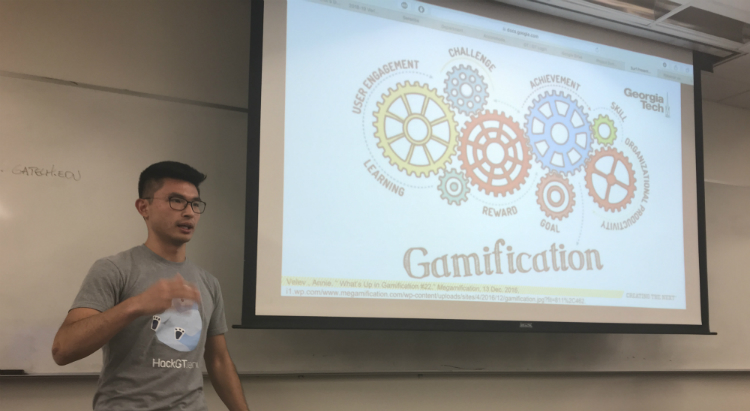I got a serious case of good vibes last night watching Georgia Tech students provide updates on six “pilot projects” that are connected to the Kendeda Building for Innovative Sustainable Design.
A couple of years ago, Architecture Professor Michael Gamble played matchmaker in putting the Kendeda Fund and Georgia Tech together on the Living Building project. Now, he’s chairing the Living Building Academic Council, which last summer doled out six grants for the pilot projects. The projects were designed and proposed by faculty members or university researchers, but most of the work is being carried out by students.
Gamble stresses that all the projects are primarily academic research efforts. But each also may at some point contribute to the building’s features, programs or operations. Now that they’ve been up and running for a semester, it’s clear that they’ve unleashed the kind of creativity that makes you wish you were back in school.
The project that got the most attention at last night’s update session (perhaps because that team brought a bonafide slide presentation) originally was tasked with developing an interactive dashboard to demystify the systems in high performance buildings. But the eight Sustainable Undergraduate Research Fellows, aka “SURFers,” who were selected to work toward that goal have taken their charge in a surprising direction.
“We wanted to gamify it,” said Leo Chen, one of the SURFers.
Rather than follow the now-familiar path of designing one large screen to display performance metrics, the group is proposing up to six interactive features throughout the building — each one very different from the others. Among the ideas: pedal-powered charging stations that would give occupants a better sense of how much energy it takes to power their phones (and a little exercise in the process), and an “aqua-clock” that measures water use against the time of day. My favorite: A “building mood/health indicator” that would incorporate “light and sound to represent the status of the building.”
“We weren’t ready for what they did,” says Michael Chang, a senior research scientist at Tech’s Brook Byers Institute for Sustainable Systems. “There are a lot of buildings that have dashboards on big screens somewhere. You might look at them once or twice, and then they get boring. What this group has come up with really surprised us.”
Chang and colleague Dana Hartley had come up with the SURFer pilot project and applied for the grant, thinking all along that the students selected would devise a state-of-the-art — but conventional — dashboard. But once it was underway, they rolled with the students’ blue-sky approach: “This is a research project. You’re not obligated to produce deliverables.”
The design and construction leaders on the Kendeda Building aren’t committed to applying any of the ideas generated by the researchers. But they do appear to be taking the projects very seriously. Howard Wertheimer, Georgia Tech’s assistant vice president for capital planning and space management, and Jimmy Mitchell of Skanska, the contractor for the building, attended last night’s session. Afterward, Wertheimer expressed enthusiasm about several of the ideas.
Regardless, the Kendeda Building is already becoming one of the most studied and thought about buildings on the Georgia Tech campus. And ground hasn’t even been broken. A student involved in a pilot project documenting biodiversity on the building site — prior to, during and after construction — reported last night that she and her teammates have so far catalogued at least 32 species; she cautioned that they haven’t gotten down to the level of breaking down ants into their individual species.
Such scrutiny over the social and environmental impacts of every aspect of a building isn’t likely to be replicated on very many other construction projects. But it points in an interesting direction: As we grade land, and construct and occupy buildings, then tear down those buildings and build new ones, we seldom stop to understand the actual effect on nearby humans, animals and plants, much less on the broader environment. How cool is it that on at least one building there’s an effort being made to develop a more mindful approach — one that investigates the potential impacts before hand, and tries to fashion ideas that do better?
PHOTO AT TOP: Georgia Tech student Leo Chen explains the “gamification” approach that he and his research teammates have brought to their study of building dashboards. Photo by Ken Edelstein.


